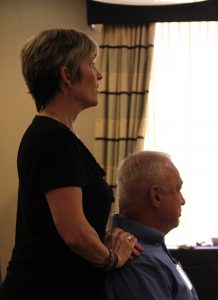Psychodrama: It’s Not Just For Groups

I was 31 years old, living in New York City, working as Director of Operations of a multi-million dollar marketing firm, making 6 figures, and by all societal measurements, “successful.” If, as Bill Wilson said in the Big Book, “I had arrived,” than why I was feeling both bored and unfulfilled? As I like to say, my work was feeding my 401K, but it wasn’t feeding my soul.
When I walked into therapy that week, instead of talking about it, in the typical “Don’t tell me, show me” fashion of psychodrama, my therapist moved me out of my chair and into action. He invited me to use the space to put out a different chair for each of my future options so we could explore them. Through his interviewing of me, as I sat in each chair, was able to explore what it felt like physically, speak from the thoughts and feelings I had sitting in each, and sort on what my next steps could be. It was kind of a Goldilocks experience – one of them was too hard (staying in my current job) and one of them was too soft (getting another job in the same industry). Surprisingly, the chair that felt “just right” and most fit what my soul was longing for was the chair that represented quitting my high-powered, high-paying job and going back to graduate school to get a degree in social work. We could have spent weeks talking about my choice, but by. moving into action instead, that Psychodrama a Deux (psychodrama between two) set me on a trajectory that I never could have imagined, and changed my life.
Most people think psychodrama is reserved soley for group work, but the truth is, it can be incredibly effective in individual therapy, too. Psychodrama A Deux allows clients to dive underneath words and concretize and experience anything: their relationship with someone else, their relationship with themselves, their relationship with a Higher Power, in a visceral way, bringing it to life in the room, rather than having it limited to the thoughts in their head and/or the feelings in their heart. It can also be vital for role training – that is, exploring and trying on a new role or behavior in the safety of therapy – to develop a felt sense of an experience, increasing the likelihood of lasting change.
While the director needs to adapt individual work to include props, scarves, etc instead of other people, Psychodrama A Deux includes most of the traditional psychodrama techniques:
- Here and Now – creating a scene in this moment, as though it’s happening right now, to allow for a “redo” of past regret or loss, or without inhabiting the fear if it is a future experience
- Doubling – having someone speak your inside voice to assist with clarity, insight, and give permission to say/feel what you might not be allowing yourself to
- Role reversal – physically inhabiting the role of someone else, or another part of self, and by “holding up a mirror” of yourself from that other role, providing greater insight, understanding and compassion for the other person and/or for yourself.
- Scene setting – concretizing a particular experience of location using the 5 senses, which allows for deeper affect and insight
- Future projection – stepping into a future time to explore that experience as though it is happening in the moment. This can be helpful to quell fears, create a vision and instill hope.
The Triadic System of Sociometry, Psychodrama and [Group] Psychotherapy – or warm up, action and sharing – can be done individually to help clients go beyond the confines of talking (and the fear and/or denial that often accompany it), take what’s going on in their heads and hearts and put it out on the “stage” to allow for exploration, aha’s and potentially, a path forward.
The warm up can be done through talk or action (eg, standing on a location on a continuum that represents whether you’re moving towards recovery or towards relapse) and the psychodrama can include chairs, scarves, props or simply locations in a room. Rather than choosing other group members to play roles, the protagonist (as the person who is doing a piece of work is called) is instructed to reverse roles (and locations) in the room to represent the “players” – significant others, parts of self, feelings, etc. The protagonist can have a dialogue with a part of self or someone else, just as readily as she/he could in a group setting.
Even when there is not a group present, the psychotherapy aspect of psychodrama, where we share how we identify with the piece of work done, is vital for “emotionally sewing up” the protagonist at the end of a session. While the therapist would not go into detail, it would be important to share in a general way with a client. For example, the therapist might say, “I know what’s it like to feel confused and not sure what decision to make, and exploring all of my options in action, rather just in words, has proven really helpful for me.” In this way, the protagonist knows that the therapist “gets it,” is less likely to feel overexposed after the drama, and the therapist can maintain his/her professional role.
Some of the benefits of using Psychodrama A Deux are:
- Exploring ambivalence
- Expressing unspoken thoughts and/or unfelt emotions (with or without role reversal)
- Dialoging with parts of self (anger, fear, addiction, etc)
- Role training (practicing) new behaviors to build competence and confidence
- Discovering and building upon strengths rather than pathology
- Exploring the future without consequence
- Exploring the future to create a plan of action (or for treatment planning)
- Saying what never got to be said, especially when there has been an ending of some kind (divorce, death of a loved one or pet, being fired, etc)
- When it’s not appropriate to do the piece in group, couples or family work due to its sensitivity, or there is a deep need for confidentiality
- To explore thoughts and feelings in preparation for an issue to be explored in group, couples or family work
While the exercise I did with my own therapist sounds “easy,” facilitating psychodrama should NOT be attempted without adequate training by a Psychodramatist, as well as good supervision. You could easily get in over your head and not only not help your client, but potentially harm him/her, particularly when working with issues of addiction and/or trauma. There are many wonderful trainers throughout the US and Canada, and if you’d like more information on locating a psychodrama trainer in your area, you can visit psychodramacertification.org.
